Detailed Financial Analysis Report of Top Glove Corporation Berhad
VerifiedAdded on 2023/06/15
|12
|2646
|290
Report
AI Summary
This report presents a detailed financial analysis of Top Glove Corporation Berhad Group for the years 2019 and 2020, employing ratio analysis to assess the company's financial health. It covers various key financial ratios, including gross profit margin, operating profit margin, return on capital employed, trade receivable and payable settlement days, inventory turnover period, revenue to capital employed, current ratio, earnings per share, and price-earnings ratio. The analysis evaluates the company's profitability, liquidity, and efficiency, highlighting both positive trends and areas needing improvement. Additionally, the report discusses factors suppliers should consider before entering into contracts with Top Glove, such as operational efficiency, market share, and technological development capacity. The report also examines the advantages and limitations of ratio analysis and further evaluates appropriate methods for valuing a listed enterprise for sale, including net asset value, price-earnings multiples, and discounted cash flow method. Desklib provides students access to this assignment and many more solved papers.
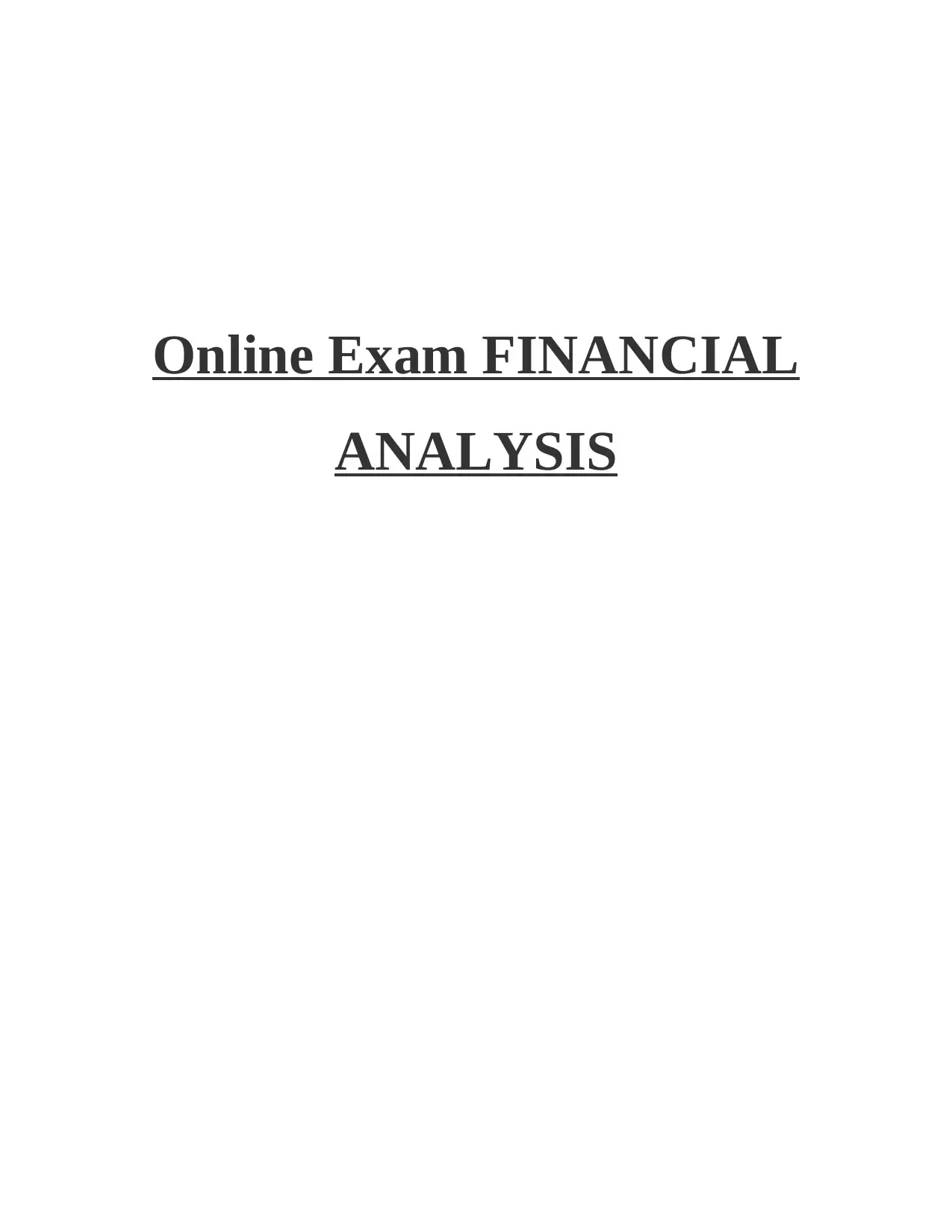
Online Exam FINANCIAL
ANALYSIS
ANALYSIS
Paraphrase This Document
Need a fresh take? Get an instant paraphrase of this document with our AI Paraphraser

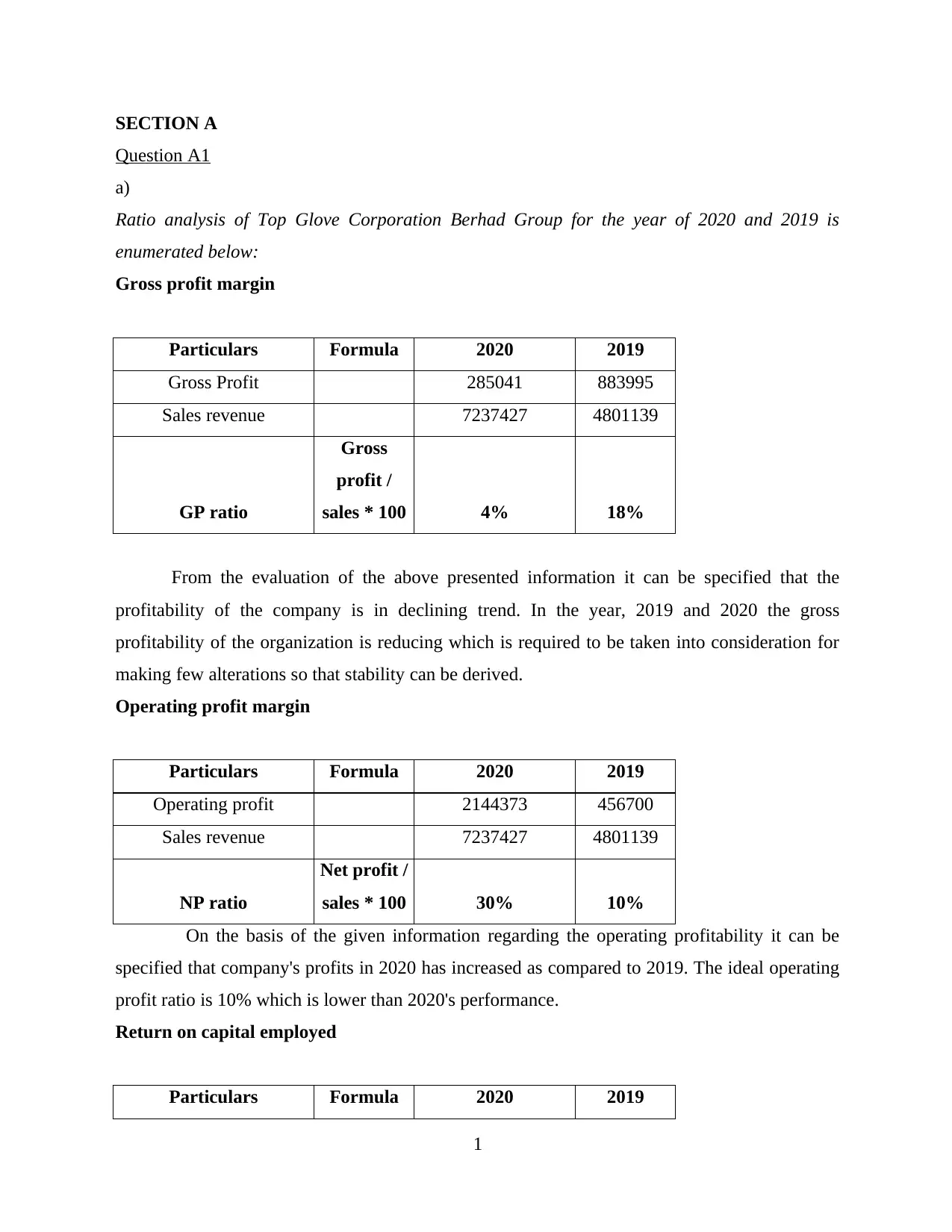
SECTION A
Question A1
a)
Ratio analysis of Top Glove Corporation Berhad Group for the year of 2020 and 2019 is
enumerated below:
Gross profit margin
Particulars Formula 2020 2019
Gross Profit 285041 883995
Sales revenue 7237427 4801139
GP ratio
Gross
profit /
sales * 100 4% 18%
From the evaluation of the above presented information it can be specified that the
profitability of the company is in declining trend. In the year, 2019 and 2020 the gross
profitability of the organization is reducing which is required to be taken into consideration for
making few alterations so that stability can be derived.
Operating profit margin
Particulars Formula 2020 2019
Operating profit 2144373 456700
Sales revenue 7237427 4801139
NP ratio
Net profit /
sales * 100 30% 10%
On the basis of the given information regarding the operating profitability it can be
specified that company's profits in 2020 has increased as compared to 2019. The ideal operating
profit ratio is 10% which is lower than 2020's performance.
Return on capital employed
Particulars Formula 2020 2019
1
Question A1
a)
Ratio analysis of Top Glove Corporation Berhad Group for the year of 2020 and 2019 is
enumerated below:
Gross profit margin
Particulars Formula 2020 2019
Gross Profit 285041 883995
Sales revenue 7237427 4801139
GP ratio
Gross
profit /
sales * 100 4% 18%
From the evaluation of the above presented information it can be specified that the
profitability of the company is in declining trend. In the year, 2019 and 2020 the gross
profitability of the organization is reducing which is required to be taken into consideration for
making few alterations so that stability can be derived.
Operating profit margin
Particulars Formula 2020 2019
Operating profit 2144373 456700
Sales revenue 7237427 4801139
NP ratio
Net profit /
sales * 100 30% 10%
On the basis of the given information regarding the operating profitability it can be
specified that company's profits in 2020 has increased as compared to 2019. The ideal operating
profit ratio is 10% which is lower than 2020's performance.
Return on capital employed
Particulars Formula 2020 2019
1
⊘ This is a preview!⊘
Do you want full access?
Subscribe today to unlock all pages.

Trusted by 1+ million students worldwide
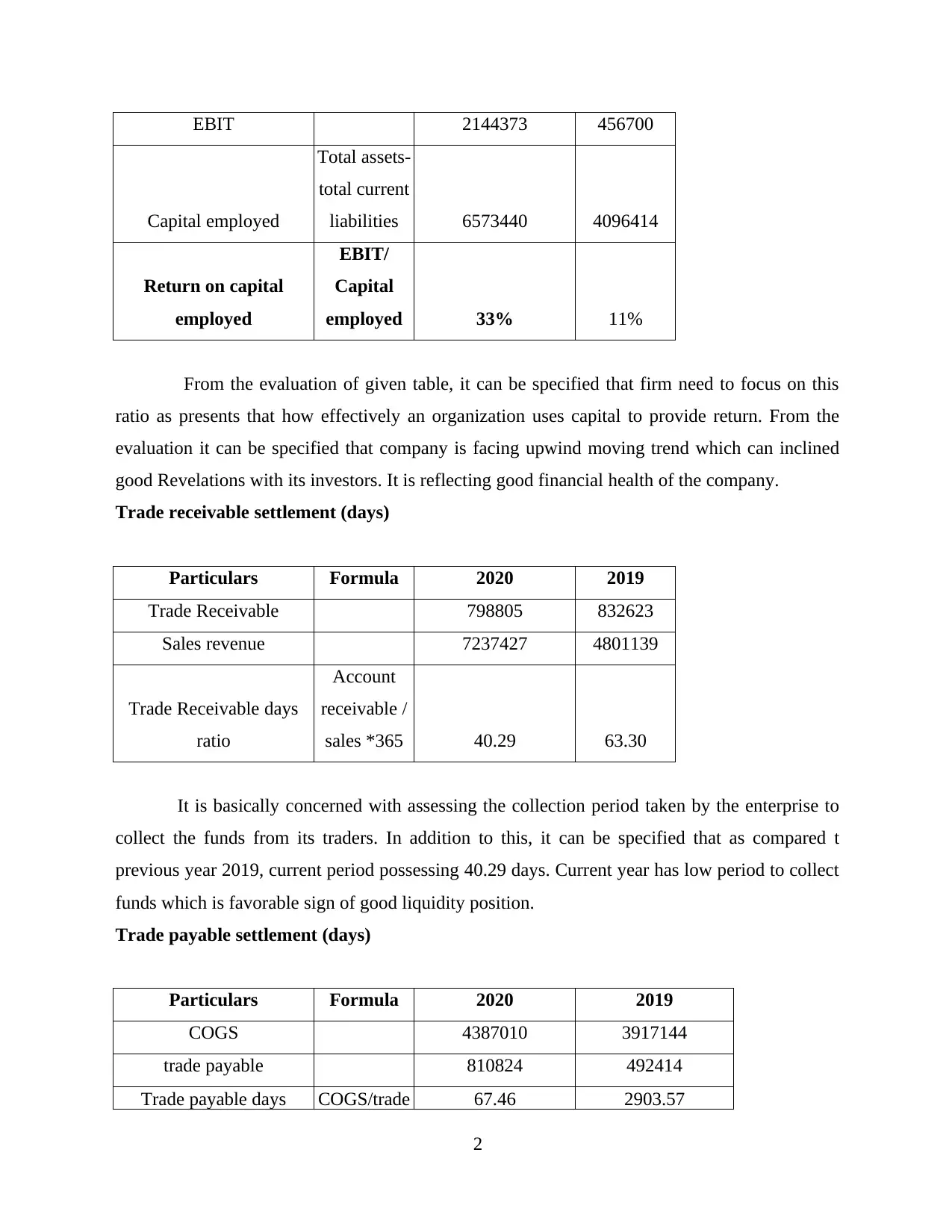
EBIT 2144373 456700
Capital employed
Total assets-
total current
liabilities 6573440 4096414
Return on capital
employed
EBIT/
Capital
employed 33% 11%
From the evaluation of given table, it can be specified that firm need to focus on this
ratio as presents that how effectively an organization uses capital to provide return. From the
evaluation it can be specified that company is facing upwind moving trend which can inclined
good Revelations with its investors. It is reflecting good financial health of the company.
Trade receivable settlement (days)
Particulars Formula 2020 2019
Trade Receivable 798805 832623
Sales revenue 7237427 4801139
Trade Receivable days
ratio
Account
receivable /
sales *365 40.29 63.30
It is basically concerned with assessing the collection period taken by the enterprise to
collect the funds from its traders. In addition to this, it can be specified that as compared t
previous year 2019, current period possessing 40.29 days. Current year has low period to collect
funds which is favorable sign of good liquidity position.
Trade payable settlement (days)
Particulars Formula 2020 2019
COGS 4387010 3917144
trade payable 810824 492414
Trade payable days COGS/trade 67.46 2903.57
2
Capital employed
Total assets-
total current
liabilities 6573440 4096414
Return on capital
employed
EBIT/
Capital
employed 33% 11%
From the evaluation of given table, it can be specified that firm need to focus on this
ratio as presents that how effectively an organization uses capital to provide return. From the
evaluation it can be specified that company is facing upwind moving trend which can inclined
good Revelations with its investors. It is reflecting good financial health of the company.
Trade receivable settlement (days)
Particulars Formula 2020 2019
Trade Receivable 798805 832623
Sales revenue 7237427 4801139
Trade Receivable days
ratio
Account
receivable /
sales *365 40.29 63.30
It is basically concerned with assessing the collection period taken by the enterprise to
collect the funds from its traders. In addition to this, it can be specified that as compared t
previous year 2019, current period possessing 40.29 days. Current year has low period to collect
funds which is favorable sign of good liquidity position.
Trade payable settlement (days)
Particulars Formula 2020 2019
COGS 4387010 3917144
trade payable 810824 492414
Trade payable days COGS/trade 67.46 2903.57
2
Paraphrase This Document
Need a fresh take? Get an instant paraphrase of this document with our AI Paraphraser
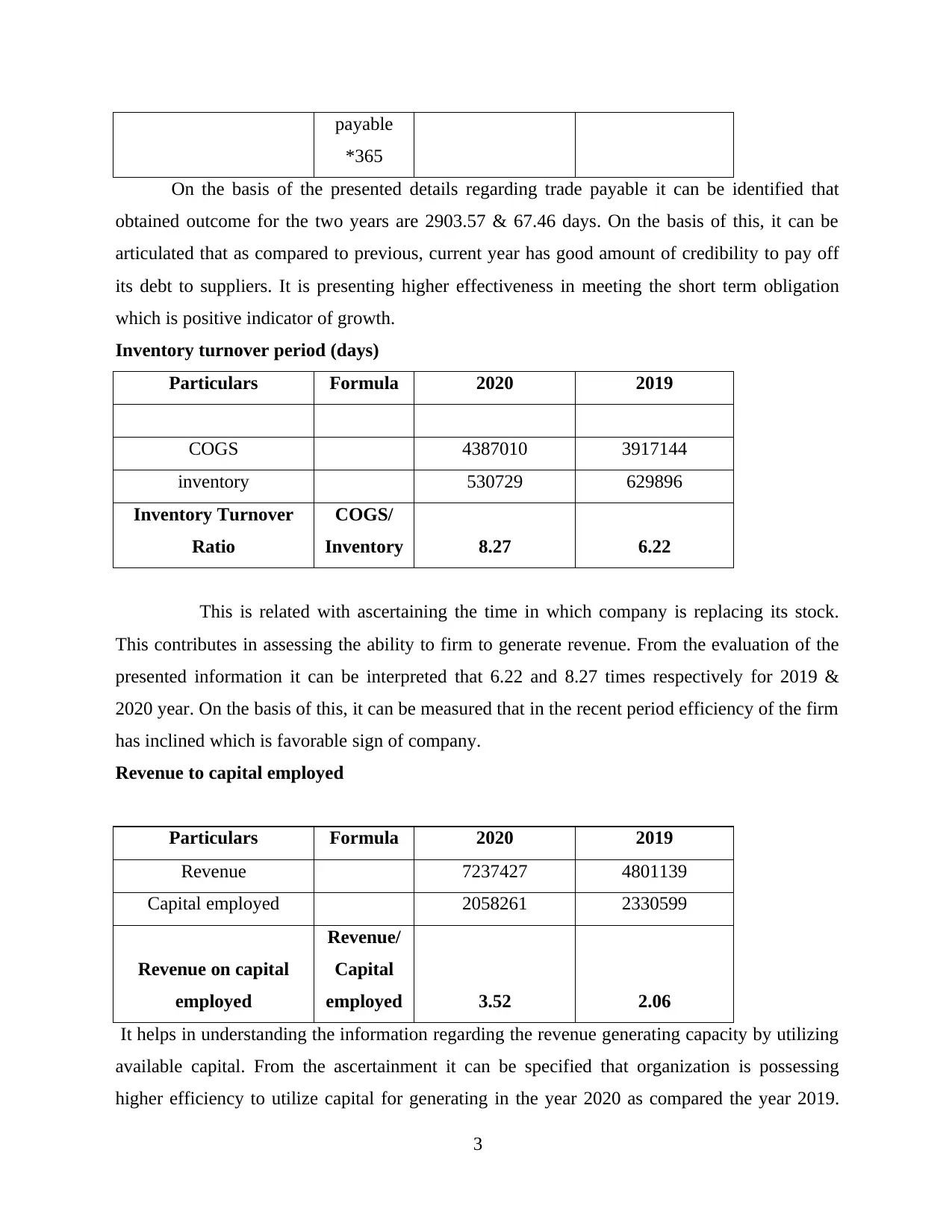
payable
*365
On the basis of the presented details regarding trade payable it can be identified that
obtained outcome for the two years are 2903.57 & 67.46 days. On the basis of this, it can be
articulated that as compared to previous, current year has good amount of credibility to pay off
its debt to suppliers. It is presenting higher effectiveness in meeting the short term obligation
which is positive indicator of growth.
Inventory turnover period (days)
Particulars Formula 2020 2019
COGS 4387010 3917144
inventory 530729 629896
Inventory Turnover
Ratio
COGS/
Inventory 8.27 6.22
This is related with ascertaining the time in which company is replacing its stock.
This contributes in assessing the ability to firm to generate revenue. From the evaluation of the
presented information it can be interpreted that 6.22 and 8.27 times respectively for 2019 &
2020 year. On the basis of this, it can be measured that in the recent period efficiency of the firm
has inclined which is favorable sign of company.
Revenue to capital employed
Particulars Formula 2020 2019
Revenue 7237427 4801139
Capital employed 2058261 2330599
Revenue on capital
employed
Revenue/
Capital
employed 3.52 2.06
It helps in understanding the information regarding the revenue generating capacity by utilizing
available capital. From the ascertainment it can be specified that organization is possessing
higher efficiency to utilize capital for generating in the year 2020 as compared the year 2019.
3
*365
On the basis of the presented details regarding trade payable it can be identified that
obtained outcome for the two years are 2903.57 & 67.46 days. On the basis of this, it can be
articulated that as compared to previous, current year has good amount of credibility to pay off
its debt to suppliers. It is presenting higher effectiveness in meeting the short term obligation
which is positive indicator of growth.
Inventory turnover period (days)
Particulars Formula 2020 2019
COGS 4387010 3917144
inventory 530729 629896
Inventory Turnover
Ratio
COGS/
Inventory 8.27 6.22
This is related with ascertaining the time in which company is replacing its stock.
This contributes in assessing the ability to firm to generate revenue. From the evaluation of the
presented information it can be interpreted that 6.22 and 8.27 times respectively for 2019 &
2020 year. On the basis of this, it can be measured that in the recent period efficiency of the firm
has inclined which is favorable sign of company.
Revenue to capital employed
Particulars Formula 2020 2019
Revenue 7237427 4801139
Capital employed 2058261 2330599
Revenue on capital
employed
Revenue/
Capital
employed 3.52 2.06
It helps in understanding the information regarding the revenue generating capacity by utilizing
available capital. From the ascertainment it can be specified that organization is possessing
higher efficiency to utilize capital for generating in the year 2020 as compared the year 2019.
3

On the basis of this, it can be interpreted that company possessing high ability to generate
revenue e which is good for the organization.
Current ratio
Particulars Formula 2020 2019
Current assets 4287653 1779097
Current liabilities 2132524 1591791
Current ratio
Current
assets /
current
liabilities 2.01 1.12
Current ratio is concerned with assessing the ability of the enterprise to use cash &
equivalent resources to overcome short term liabilities. It permits different kinds of stakeholder
to get the information regarding the ability so that sound decision can be made (Rustagi,
2021).
Earnings per share
Particulars Formula 2020 2019
Net income 1788830 367546
Number of shares
outstanding 2708697 2559814
Earnings per share
Net
income/Nu
mber of
shares
outstanding 0.56 0.14
4
revenue e which is good for the organization.
Current ratio
Particulars Formula 2020 2019
Current assets 4287653 1779097
Current liabilities 2132524 1591791
Current ratio
Current
assets /
current
liabilities 2.01 1.12
Current ratio is concerned with assessing the ability of the enterprise to use cash &
equivalent resources to overcome short term liabilities. It permits different kinds of stakeholder
to get the information regarding the ability so that sound decision can be made (Rustagi,
2021).
Earnings per share
Particulars Formula 2020 2019
Net income 1788830 367546
Number of shares
outstanding 2708697 2559814
Earnings per share
Net
income/Nu
mber of
shares
outstanding 0.56 0.14
4
⊘ This is a preview!⊘
Do you want full access?
Subscribe today to unlock all pages.

Trusted by 1+ million students worldwide
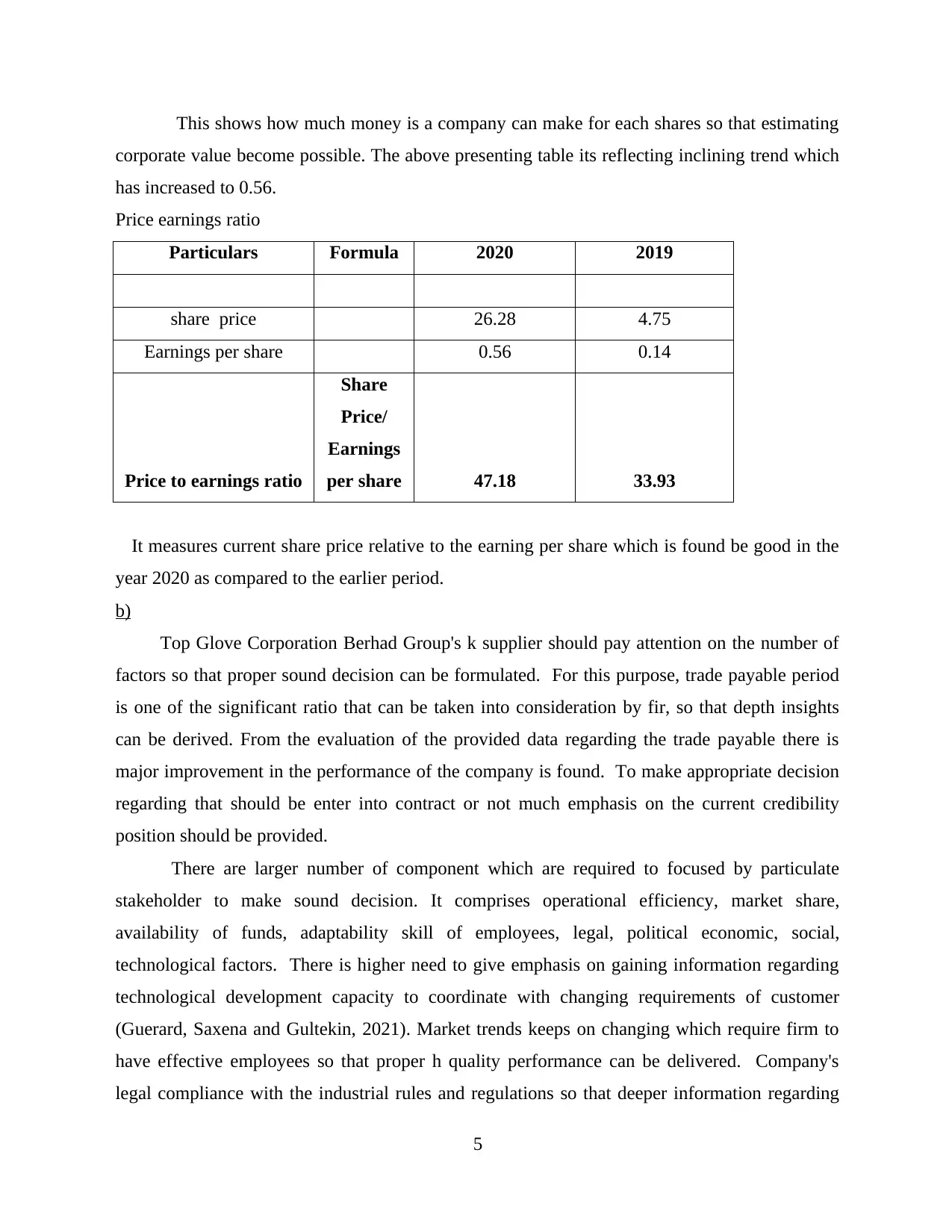
This shows how much money is a company can make for each shares so that estimating
corporate value become possible. The above presenting table its reflecting inclining trend which
has increased to 0.56.
Price earnings ratio
Particulars Formula 2020 2019
share price 26.28 4.75
Earnings per share 0.56 0.14
Price to earnings ratio
Share
Price/
Earnings
per share 47.18 33.93
It measures current share price relative to the earning per share which is found be good in the
year 2020 as compared to the earlier period.
b)
Top Glove Corporation Berhad Group's k supplier should pay attention on the number of
factors so that proper sound decision can be formulated. For this purpose, trade payable period
is one of the significant ratio that can be taken into consideration by fir, so that depth insights
can be derived. From the evaluation of the provided data regarding the trade payable there is
major improvement in the performance of the company is found. To make appropriate decision
regarding that should be enter into contract or not much emphasis on the current credibility
position should be provided.
There are larger number of component which are required to focused by particulate
stakeholder to make sound decision. It comprises operational efficiency, market share,
availability of funds, adaptability skill of employees, legal, political economic, social,
technological factors. There is higher need to give emphasis on gaining information regarding
technological development capacity to coordinate with changing requirements of customer
(Guerard, Saxena and Gultekin, 2021). Market trends keeps on changing which require firm to
have effective employees so that proper h quality performance can be delivered. Company's
legal compliance with the industrial rules and regulations so that deeper information regarding
5
corporate value become possible. The above presenting table its reflecting inclining trend which
has increased to 0.56.
Price earnings ratio
Particulars Formula 2020 2019
share price 26.28 4.75
Earnings per share 0.56 0.14
Price to earnings ratio
Share
Price/
Earnings
per share 47.18 33.93
It measures current share price relative to the earning per share which is found be good in the
year 2020 as compared to the earlier period.
b)
Top Glove Corporation Berhad Group's k supplier should pay attention on the number of
factors so that proper sound decision can be formulated. For this purpose, trade payable period
is one of the significant ratio that can be taken into consideration by fir, so that depth insights
can be derived. From the evaluation of the provided data regarding the trade payable there is
major improvement in the performance of the company is found. To make appropriate decision
regarding that should be enter into contract or not much emphasis on the current credibility
position should be provided.
There are larger number of component which are required to focused by particulate
stakeholder to make sound decision. It comprises operational efficiency, market share,
availability of funds, adaptability skill of employees, legal, political economic, social,
technological factors. There is higher need to give emphasis on gaining information regarding
technological development capacity to coordinate with changing requirements of customer
(Guerard, Saxena and Gultekin, 2021). Market trends keeps on changing which require firm to
have effective employees so that proper h quality performance can be delivered. Company's
legal compliance with the industrial rules and regulations so that deeper information regarding
5
Paraphrase This Document
Need a fresh take? Get an instant paraphrase of this document with our AI Paraphraser
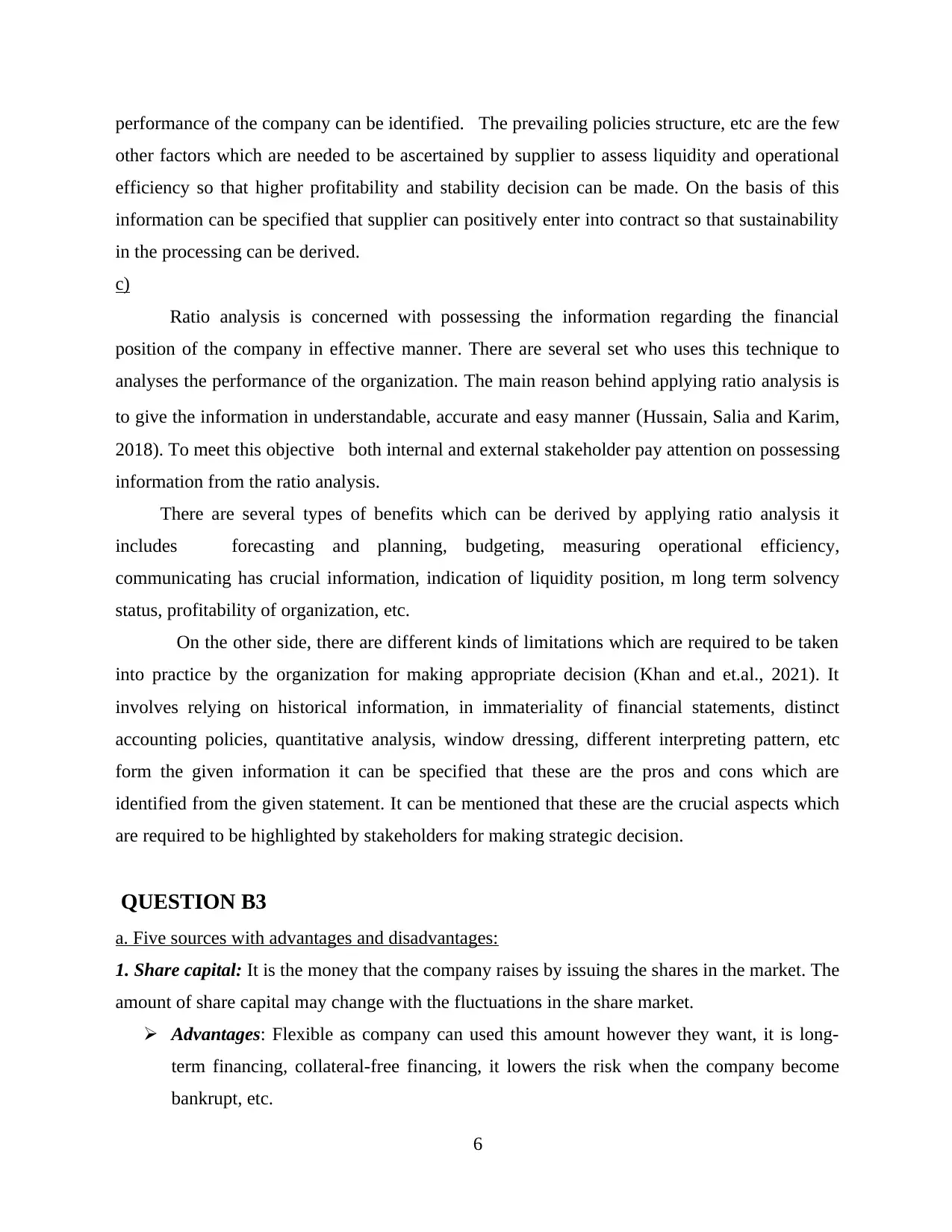
performance of the company can be identified. The prevailing policies structure, etc are the few
other factors which are needed to be ascertained by supplier to assess liquidity and operational
efficiency so that higher profitability and stability decision can be made. On the basis of this
information can be specified that supplier can positively enter into contract so that sustainability
in the processing can be derived.
c)
Ratio analysis is concerned with possessing the information regarding the financial
position of the company in effective manner. There are several set who uses this technique to
analyses the performance of the organization. The main reason behind applying ratio analysis is
to give the information in understandable, accurate and easy manner (Hussain, Salia and Karim,
2018). To meet this objective both internal and external stakeholder pay attention on possessing
information from the ratio analysis.
There are several types of benefits which can be derived by applying ratio analysis it
includes forecasting and planning, budgeting, measuring operational efficiency,
communicating has crucial information, indication of liquidity position, m long term solvency
status, profitability of organization, etc.
On the other side, there are different kinds of limitations which are required to be taken
into practice by the organization for making appropriate decision (Khan and et.al., 2021). It
involves relying on historical information, in immateriality of financial statements, distinct
accounting policies, quantitative analysis, window dressing, different interpreting pattern, etc
form the given information it can be specified that these are the pros and cons which are
identified from the given statement. It can be mentioned that these are the crucial aspects which
are required to be highlighted by stakeholders for making strategic decision.
QUESTION B3
a. Five sources with advantages and disadvantages:
1. Share capital: It is the money that the company raises by issuing the shares in the market. The
amount of share capital may change with the fluctuations in the share market.
Advantages: Flexible as company can used this amount however they want, it is long-
term financing, collateral-free financing, it lowers the risk when the company become
bankrupt, etc.
6
other factors which are needed to be ascertained by supplier to assess liquidity and operational
efficiency so that higher profitability and stability decision can be made. On the basis of this
information can be specified that supplier can positively enter into contract so that sustainability
in the processing can be derived.
c)
Ratio analysis is concerned with possessing the information regarding the financial
position of the company in effective manner. There are several set who uses this technique to
analyses the performance of the organization. The main reason behind applying ratio analysis is
to give the information in understandable, accurate and easy manner (Hussain, Salia and Karim,
2018). To meet this objective both internal and external stakeholder pay attention on possessing
information from the ratio analysis.
There are several types of benefits which can be derived by applying ratio analysis it
includes forecasting and planning, budgeting, measuring operational efficiency,
communicating has crucial information, indication of liquidity position, m long term solvency
status, profitability of organization, etc.
On the other side, there are different kinds of limitations which are required to be taken
into practice by the organization for making appropriate decision (Khan and et.al., 2021). It
involves relying on historical information, in immateriality of financial statements, distinct
accounting policies, quantitative analysis, window dressing, different interpreting pattern, etc
form the given information it can be specified that these are the pros and cons which are
identified from the given statement. It can be mentioned that these are the crucial aspects which
are required to be highlighted by stakeholders for making strategic decision.
QUESTION B3
a. Five sources with advantages and disadvantages:
1. Share capital: It is the money that the company raises by issuing the shares in the market. The
amount of share capital may change with the fluctuations in the share market.
Advantages: Flexible as company can used this amount however they want, it is long-
term financing, collateral-free financing, it lowers the risk when the company become
bankrupt, etc.
6
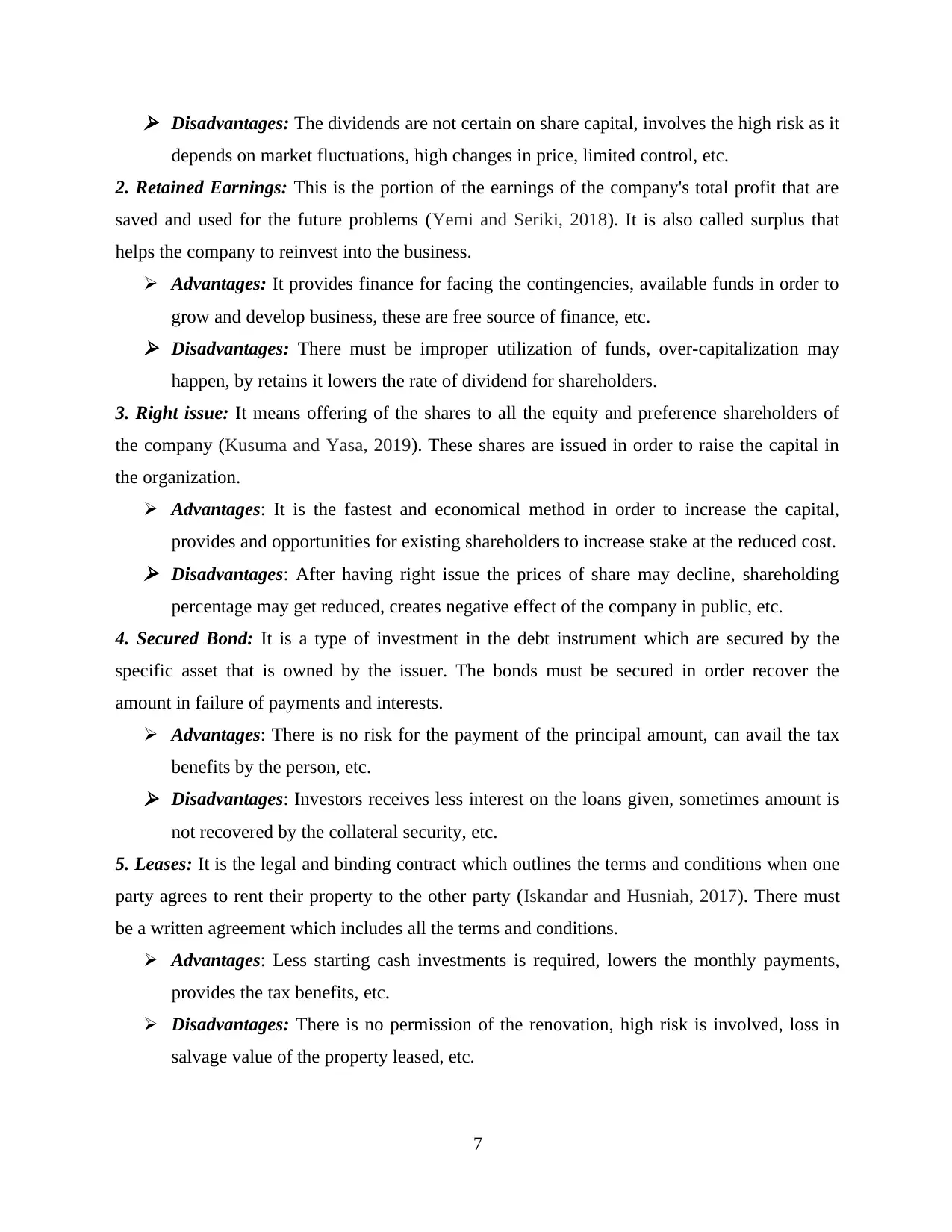
Disadvantages: The dividends are not certain on share capital, involves the high risk as it
depends on market fluctuations, high changes in price, limited control, etc.
2. Retained Earnings: This is the portion of the earnings of the company's total profit that are
saved and used for the future problems (Yemi and Seriki, 2018). It is also called surplus that
helps the company to reinvest into the business.
Advantages: It provides finance for facing the contingencies, available funds in order to
grow and develop business, these are free source of finance, etc. Disadvantages: There must be improper utilization of funds, over-capitalization may
happen, by retains it lowers the rate of dividend for shareholders.
3. Right issue: It means offering of the shares to all the equity and preference shareholders of
the company (Kusuma and Yasa, 2019). These shares are issued in order to raise the capital in
the organization.
Advantages: It is the fastest and economical method in order to increase the capital,
provides and opportunities for existing shareholders to increase stake at the reduced cost. Disadvantages: After having right issue the prices of share may decline, shareholding
percentage may get reduced, creates negative effect of the company in public, etc.
4. Secured Bond: It is a type of investment in the debt instrument which are secured by the
specific asset that is owned by the issuer. The bonds must be secured in order recover the
amount in failure of payments and interests.
Advantages: There is no risk for the payment of the principal amount, can avail the tax
benefits by the person, etc. Disadvantages: Investors receives less interest on the loans given, sometimes amount is
not recovered by the collateral security, etc.
5. Leases: It is the legal and binding contract which outlines the terms and conditions when one
party agrees to rent their property to the other party (Iskandar and Husniah, 2017). There must
be a written agreement which includes all the terms and conditions.
Advantages: Less starting cash investments is required, lowers the monthly payments,
provides the tax benefits, etc.
Disadvantages: There is no permission of the renovation, high risk is involved, loss in
salvage value of the property leased, etc.
7
depends on market fluctuations, high changes in price, limited control, etc.
2. Retained Earnings: This is the portion of the earnings of the company's total profit that are
saved and used for the future problems (Yemi and Seriki, 2018). It is also called surplus that
helps the company to reinvest into the business.
Advantages: It provides finance for facing the contingencies, available funds in order to
grow and develop business, these are free source of finance, etc. Disadvantages: There must be improper utilization of funds, over-capitalization may
happen, by retains it lowers the rate of dividend for shareholders.
3. Right issue: It means offering of the shares to all the equity and preference shareholders of
the company (Kusuma and Yasa, 2019). These shares are issued in order to raise the capital in
the organization.
Advantages: It is the fastest and economical method in order to increase the capital,
provides and opportunities for existing shareholders to increase stake at the reduced cost. Disadvantages: After having right issue the prices of share may decline, shareholding
percentage may get reduced, creates negative effect of the company in public, etc.
4. Secured Bond: It is a type of investment in the debt instrument which are secured by the
specific asset that is owned by the issuer. The bonds must be secured in order recover the
amount in failure of payments and interests.
Advantages: There is no risk for the payment of the principal amount, can avail the tax
benefits by the person, etc. Disadvantages: Investors receives less interest on the loans given, sometimes amount is
not recovered by the collateral security, etc.
5. Leases: It is the legal and binding contract which outlines the terms and conditions when one
party agrees to rent their property to the other party (Iskandar and Husniah, 2017). There must
be a written agreement which includes all the terms and conditions.
Advantages: Less starting cash investments is required, lowers the monthly payments,
provides the tax benefits, etc.
Disadvantages: There is no permission of the renovation, high risk is involved, loss in
salvage value of the property leased, etc.
7
⊘ This is a preview!⊘
Do you want full access?
Subscribe today to unlock all pages.

Trusted by 1+ million students worldwide

b. Critically evaluating the appropriate method when valuing a listed enterprise for sale
Net asset value: Net asset value that is NAV of the entity is calculated by the value of the
firm’s assets minus the value of the liabilities of the firm. Securities and exchange commission
are also redeemed at their net asset value (Sumantyo and Savitri, 2019). This makes the
company to have accurate valuation of the assets in order to have good decision for company. It
is used by company to identify the potential investments benefits in mutual fund or indexes. But
this valuation did not reflect the benefits to the company for the future point of view.
Price earnings multiples: This method used to compare the earning per share that is
reported by the company to the price of the market of its common stock. These multiples are
used by the investors in order to judge that how the expensive a share of the company's stock. It
is calculated by dividing the market value of the per share by the company's earning on per
share. It si sometimes difficult to compare companies around the industries. It is one of the best
method to do the valuation of the stocks in the company.
Discounted cash flow method: Discounted cash flow is the method of valuation which si
used to estimate the value of the investment which is basically based on the future cash flows of
the company. The present value of the expected cash flow is taken out by using this method of
valuation (Li and et.al., 2017). If the current cost of the capital is lower than discounted cash
flow the organization has opportunity to have positive returns to the future. These methods have
limitation like that it believes on the estimations of the expected future cash flow, which may be
proved wrong by the company in the future.
The best and appropriate method that the company can have when valuing the
organization for sale is the Net asset value. This is the most appropriate because the calculated
by the value of the firm’s assets subtracting the value of the liabilities of the organization. By
this the listed enterprise can get the best value of their organization. By having this method, the
company can have the best investment opportunities in the future.
8
Net asset value: Net asset value that is NAV of the entity is calculated by the value of the
firm’s assets minus the value of the liabilities of the firm. Securities and exchange commission
are also redeemed at their net asset value (Sumantyo and Savitri, 2019). This makes the
company to have accurate valuation of the assets in order to have good decision for company. It
is used by company to identify the potential investments benefits in mutual fund or indexes. But
this valuation did not reflect the benefits to the company for the future point of view.
Price earnings multiples: This method used to compare the earning per share that is
reported by the company to the price of the market of its common stock. These multiples are
used by the investors in order to judge that how the expensive a share of the company's stock. It
is calculated by dividing the market value of the per share by the company's earning on per
share. It si sometimes difficult to compare companies around the industries. It is one of the best
method to do the valuation of the stocks in the company.
Discounted cash flow method: Discounted cash flow is the method of valuation which si
used to estimate the value of the investment which is basically based on the future cash flows of
the company. The present value of the expected cash flow is taken out by using this method of
valuation (Li and et.al., 2017). If the current cost of the capital is lower than discounted cash
flow the organization has opportunity to have positive returns to the future. These methods have
limitation like that it believes on the estimations of the expected future cash flow, which may be
proved wrong by the company in the future.
The best and appropriate method that the company can have when valuing the
organization for sale is the Net asset value. This is the most appropriate because the calculated
by the value of the firm’s assets subtracting the value of the liabilities of the organization. By
this the listed enterprise can get the best value of their organization. By having this method, the
company can have the best investment opportunities in the future.
8
Paraphrase This Document
Need a fresh take? Get an instant paraphrase of this document with our AI Paraphraser
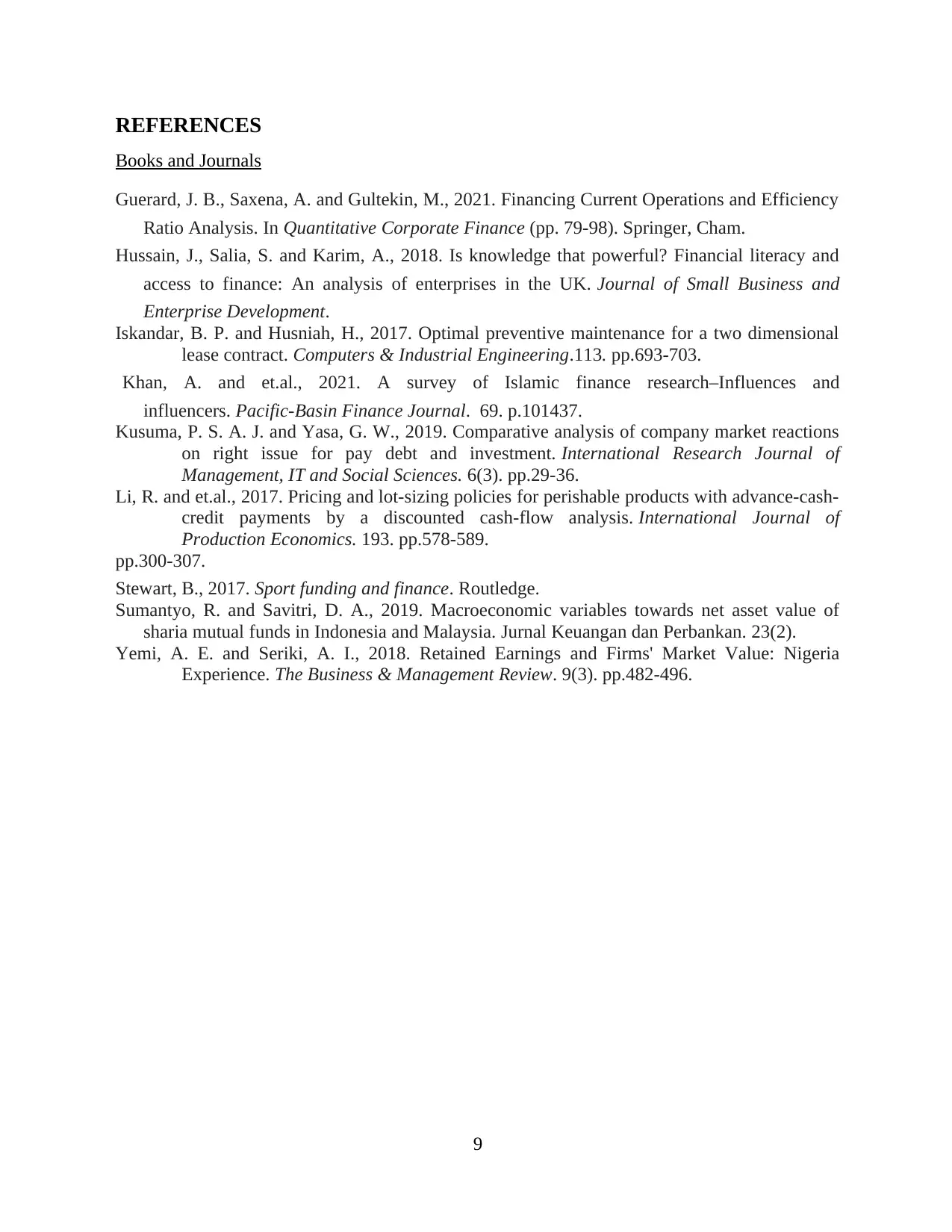
REFERENCES
Books and Journals
Guerard, J. B., Saxena, A. and Gultekin, M., 2021. Financing Current Operations and Efficiency
Ratio Analysis. In Quantitative Corporate Finance (pp. 79-98). Springer, Cham.
Hussain, J., Salia, S. and Karim, A., 2018. Is knowledge that powerful? Financial literacy and
access to finance: An analysis of enterprises in the UK. Journal of Small Business and
Enterprise Development.
Iskandar, B. P. and Husniah, H., 2017. Optimal preventive maintenance for a two dimensional
lease contract. Computers & Industrial Engineering.113. pp.693-703.
Khan, A. and et.al., 2021. A survey of Islamic finance research–Influences and
influencers. Pacific-Basin Finance Journal. 69. p.101437.
Kusuma, P. S. A. J. and Yasa, G. W., 2019. Comparative analysis of company market reactions
on right issue for pay debt and investment. International Research Journal of
Management, IT and Social Sciences. 6(3). pp.29-36.
Li, R. and et.al., 2017. Pricing and lot-sizing policies for perishable products with advance-cash-
credit payments by a discounted cash-flow analysis. International Journal of
Production Economics. 193. pp.578-589.
pp.300-307.
Stewart, B., 2017. Sport funding and finance. Routledge.
Sumantyo, R. and Savitri, D. A., 2019. Macroeconomic variables towards net asset value of
sharia mutual funds in Indonesia and Malaysia. Jurnal Keuangan dan Perbankan. 23(2).
Yemi, A. E. and Seriki, A. I., 2018. Retained Earnings and Firms' Market Value: Nigeria
Experience. The Business & Management Review. 9(3). pp.482-496.
9
Books and Journals
Guerard, J. B., Saxena, A. and Gultekin, M., 2021. Financing Current Operations and Efficiency
Ratio Analysis. In Quantitative Corporate Finance (pp. 79-98). Springer, Cham.
Hussain, J., Salia, S. and Karim, A., 2018. Is knowledge that powerful? Financial literacy and
access to finance: An analysis of enterprises in the UK. Journal of Small Business and
Enterprise Development.
Iskandar, B. P. and Husniah, H., 2017. Optimal preventive maintenance for a two dimensional
lease contract. Computers & Industrial Engineering.113. pp.693-703.
Khan, A. and et.al., 2021. A survey of Islamic finance research–Influences and
influencers. Pacific-Basin Finance Journal. 69. p.101437.
Kusuma, P. S. A. J. and Yasa, G. W., 2019. Comparative analysis of company market reactions
on right issue for pay debt and investment. International Research Journal of
Management, IT and Social Sciences. 6(3). pp.29-36.
Li, R. and et.al., 2017. Pricing and lot-sizing policies for perishable products with advance-cash-
credit payments by a discounted cash-flow analysis. International Journal of
Production Economics. 193. pp.578-589.
pp.300-307.
Stewart, B., 2017. Sport funding and finance. Routledge.
Sumantyo, R. and Savitri, D. A., 2019. Macroeconomic variables towards net asset value of
sharia mutual funds in Indonesia and Malaysia. Jurnal Keuangan dan Perbankan. 23(2).
Yemi, A. E. and Seriki, A. I., 2018. Retained Earnings and Firms' Market Value: Nigeria
Experience. The Business & Management Review. 9(3). pp.482-496.
9

<https://ohiostate.pressbooks.pub/drivechange/chapter/chapter-1/>.
10
10
⊘ This is a preview!⊘
Do you want full access?
Subscribe today to unlock all pages.

Trusted by 1+ million students worldwide
1 out of 12
Related Documents
Your All-in-One AI-Powered Toolkit for Academic Success.
+13062052269
info@desklib.com
Available 24*7 on WhatsApp / Email
![[object Object]](/_next/static/media/star-bottom.7253800d.svg)
Unlock your academic potential
Copyright © 2020–2025 A2Z Services. All Rights Reserved. Developed and managed by ZUCOL.




